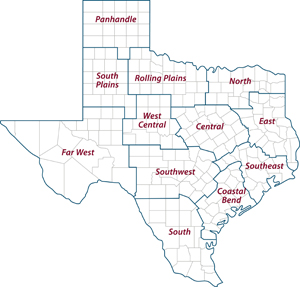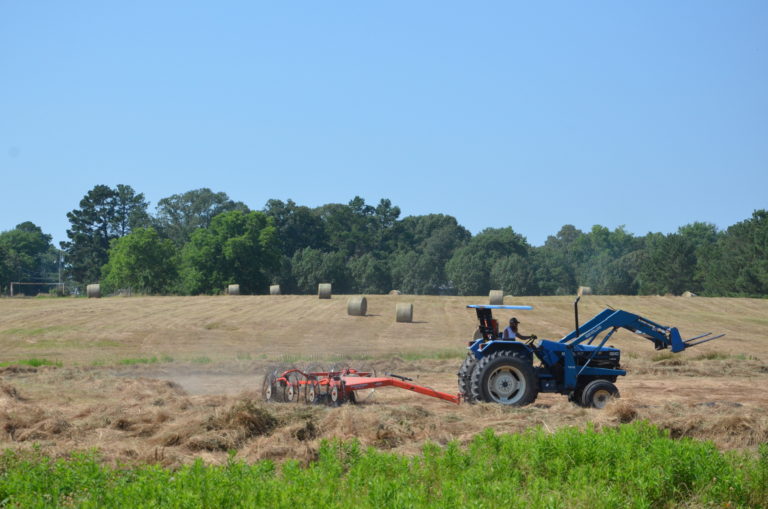Texas Crop & Weather Report
Texas’ carryover hay supplies are low, and production is off to a slow start due to spring rain delays, according to Texas A&M AgriLife Extension Service experts.
Dr. David Anderson, AgriLife Extension economist, College Station, said a cold winter in 2017 and drought conditions in 2018 led to declining hay supplies. Texas hay supplies are 50 percent lower than they were this time in 2017, according to the May 1 Texas and Southwestern Cattle Raisers Association hay stocks report.
“Producers used up a lot of hay to get through winter 2017, and drought hindered production this last growing season,” he said. “Then you had a long, wet winter for a lot of the state’s production areas. It’s no wonder we’ve seen declines.”
Despite the declines, Anderson said hay stocks are better now than in 2018. But supplies are also 18 percent below Texas’ 10-year average.
“Those years include 2006-2007, which were dry years and of course major drought years of 2012 and 2013,” he said. “So that indicates some really thin supplies.”
Prices around Texas throughout the winter reflected low supplies. In a Texas Crop and Weather Report from July 2018, Anderson said round bales that sold for $50-$65 in early July 2017 were selling for $70-$90.
AgriLife Extension agent reports in some areas of Texas reported prices beyond $100 per round bale later that year.
Hay inventories are also tight, down more than 50 percent, in surrounding states — Louisiana, Oklahoma, Kansas and Missouri — compared to 2017.
Short hay supplies statewide are compounded by demand from a growing beef cattle herd. Texas’ herd is now 4.65 million head, up almost 750,000 since the major drought ended.
So far, too much rain has hindered producers’ ability to maximize production via fertilization and weed control, but Anderson is optimistic the moisture will translate into a bumper crop for 2019.
Dr. Vanessa Corriher-Olson, AgriLife Extension forage specialist, Overton, said she worries the delays may be too much for hay producers to overcome over the season.
The first cutting of hay, to clear cool-season forages, especially volunteer ryegrass, typically is done by April, she said. Many producers in Southeast and East Texas are just now cutting and baling the first cutting. Some still can’t access their pastures because of soggy conditions.
The first cutting is important to clear the pasture canopy to promote Bermuda grass emergence and reduce competition for soil nutrients, moisture and sunlight, she said.
“Because it’s late May, we may not get the first cutting of Bermuda grass until late June,” she said. “That fact, unfortunately, could lead to lower hay production over the growing season as a whole.”
Corriher-Olson said other areas in the state may have fared better than Southeast and East Texas, and that overall Texas’ soil moisture levels are better at this point in the year than almost a decade. The National Oceanic and Atmospheric Administration’s Seasonal Drought Outlook showed Texas completely clear of drought conditions.
The 90-day outlook was also promising regarding moisture for the state.
But Corriher-Olson said more than anything, hay producers need sunshine and the ability to access fields.
“The biggest challenge for producers now is getting into their fields to fertilize or treat weeds, to cut and bale or all of the above,” she said. “They need dry conditions to do that. It takes three days to cut, windrow and bale hay, and high humidity makes that more difficult. That will continue to be a challenge if we receive intermittent rains into July.”
AgriLife Extension district reporters compiled the following summaries:

CENTRAL: Some areas received heavy rains with flooding in low areas. Freestone County reported more than 7 inches of rain during one rain event. Farmers could get into some sandy fields by the end of the week, but more rain was in the forecast. Farmers were unable to plant cotton due to wet conditions in areas. Cotton planted before the last big rain will probably need to be replanted. Brush and weed control were done throughout Erath County. Livestock were in good condition. Corn was growing due to rain and was starting to silk in some areas. Nearly all counties reported good soil moisture. Overall crop, pasture and rangeland conditions were good in most counties.
ROLLING PLAINS: Producers reported favorable weather conditions as temperatures warmed. Soil moisture levels were good. Some area producers baled wheat hay while others prepared for grain harvest. Some wheat yields were expected to be affected by rust. Cattle producers reported good weight gains on cattle as they were pulled off wheat. Native rangelands and improved pastures continued to improve and were in good condition across the district. Cotton producers continued to prepare fields, and some began planting.
COASTAL BEND: Scattered showers were reported in some areas while other areas reported no rainfall. Soil moisture was mostly ample, and temperatures were seasonal. Cotton was starting to grow and square. Corn and sorghum looked good. Some rice was yet to be planted. Herbicides to control grasses and weeds were applied. Pastures were lush. First hay cuttings were expected to have high yields when conditions dry. Cattle remained in excellent condition.
EAST: Cherokee County reported severe flooding after receiving up to 7.5 inches of rain. Several other counties reported rain amounts of 1-6 inches, while Harrison County reported dry conditions. Many gardens and vegetable fields were a total loss due to heavy rains. Some hay cutting and baling was done. Producers in Smith County were trying to get fertilizers out. Wet conditions made it impossible for producers in some counties to get equipment in hay fields. Houston County producers turned cattle out on ryegrass fields meant for hay. Cattle conditions were improving. Prices on heavy calves were lower while lighter calves were a little higher. Shelby County reported a solid cattle market, but numbers were down due to rain giving producers trouble getting cattle out. Brewster County reported a high daytime temperature of 96 degrees.
SOUTH PLAINS: Parts of the district received trace amounts of rain up to 2 inches. More rain was forecast, with potential for severe weather. Subsoil and topsoil moisture levels improved with recent rains. Conditions allowed farmers to plant cotton, haygrazer and sorghum. Pasture, rangeland and winter wheat improved due to the moisture. Small-grain silage harvest neared completion. Stock tanks had water, but many were not full. Cattle were in good condition.
PANHANDLE: Temperatures were warm with little moisture received. Rangelands and pastures were green. Conditions were good to plant, and producers were productive. Winter wheat progressed with many fields headed to blooming. Cotton germination was behind due to above-average moisture received. Soil moisture conditions remained excellent.
NORTH: Soil moisture was adequate to surplus in most counties with 1 to 3 inches of rainfall reported across the district. Some hay harvesting was done before rains arrived. Warm-season grasses were slow to emerge due to cool nights and low soil temperatures. Coastal Bermuda grass should come on strong once producers cut winter grasses and nights get warmer. Winter wheat was doing well. Corn on higher ground was doing well. Corn in low-lying areas was affected by standing water. Sorghum was taking off, with few problems reported other than a few armyworms. Moisture was expected to interfere with the drying process in grains and may cause delays for working fields. Some cotton and beans were planted. The rest of forage sorghum was planted. Livestock were in great condition as pastures thrived. Weekend storms did cause stress in livestock. Horn flies were already a huge problem this season.
FAR WEST: Temperature averaged in the upper 90s with lows in the mid-50s. Precipitation for the region has varied from trace amounts up to 5 inches. Heavy winds, rains, hail and even a few tornadoes were reported and affected crops, trees and outbuildings. Cotton and alfalfa were planted. Pecan trees were still dropping tassels. Trees were being sprayed due to pecan nut casebearers numbers. Rangelands were in good condition and producing adequate forage for livestock. Shipping of lambs continued.
WEST CENTRAL: Conditions were warm and dry. Winter wheat fields were nearing maturity and mostly in good to excellent condition. Producers who planned to bale wheat for hay were unable to due to rains. Some wheat acreage was past the optimum growth stage for baling. Cotton planting was on hold due to wet field conditions. Grain and forage sorghums were in mostly good condition. Rangelands and pastures were in excellent condition. Livestock were in good condition. The cattle market was active with lower condition stocker steers and heifers selling steadily. Feeder heifers were $2 lower. Packer cows and bulls were $3 higher. Fleshy to fat calves were $3-$5 lower per hundredweight. Feeder steers were steady. Pairs and bred cows were steady.
SOUTHEAST: Moisture levels were still surplus in many areas of the district. Conditions dried some, but rain was in the forecast. Several counties reported wet conditions in low-lying areas. Producers started the first hay cutting on higher ground and drier parts of the district. Wet conditions kept farmers from planting, but farmers were going to make a last push to get rice planted soon. Rangeland and pasture ratings were excellent to poor with good being most common.
SOUTHWEST: Rangeland and pasture conditions continued to improve with recent rains. Bermuda grass pastures were beginning to do well. Weed and fertilizer applications continued. Some counties started to harvest wheat, while others were waiting for conditions to dry. Rivers were flowing good, and previously dry creeks had flowing water. Livestock were in great condition aside from flies on cows.
SOUTH: Northern parts of the district reported mild weather and adequate soil moisture levels. Western parts reported mild weather conditions with short to adequate soil moisture levels. Eastern parts of the district reported wet weather with short to adequate soil moisture levels. Wet weather was also reported in the southernmost parts of the district, but soil moisture levels remained short. Most counties reported good growing conditions. Maverick County reported some rain, up to 1 inch in some areas. Cotton planting was winding up. Early planted cotton was starting to square. Peanut plantings started and were expected to pick up soon. Wheat and potato harvests were in full swing. Strawberry harvest was winding down. Corn fields were silking. Excellent yield potentials were reported for earlier-planted corn and sorghum. Bermuda grass was cut and baled for hay. Watermelons and cantaloupes were in good condition. Cabbage harvest resumed, and onion harvest was active and expected to end soon. Livestock were in good condition. Native rangeland and pastures responded well to recent rainfall. Forage production was good to excellent. Pecan producers were clearing weeds and grasses. Dimmit County reported needing runoff-producing rains to fill tanks. Some producers were still hauling water and supplemental feeding in some areas.





